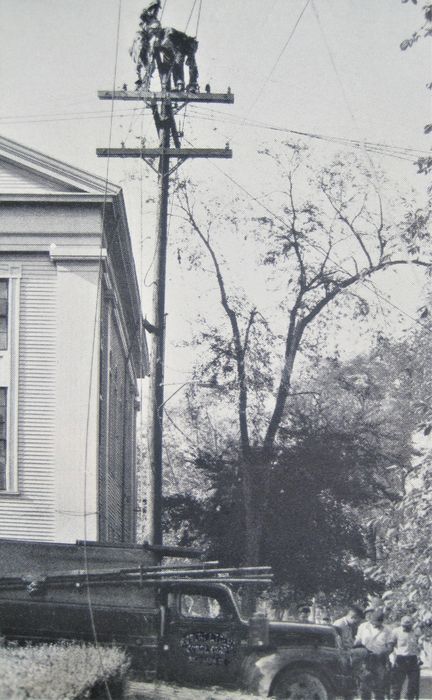Hingham Municipal Lighting Plant, MA, 1954 Hurricanes Carol and Edna, Linemen.
By Joe Maurath, Jr.; posted August 22, 2020
View Original: Click to zoom, then click to magnify (1879 x 3047) 2156KB

|
In late August a furious hurricane over open water marched northward and made landfall on the western side of Long Island (New York). From there Carol's unforgiving winds lashed into Connecticut and Massachusetts, continuing northward through the center portion of the latter and then into northern New England with its center near the NH - VT state line. The storm had a very wide wind field that whipped through easterly regions all the way across to the coast (including Cape Cod) for at least a hundred miles with hurricane force gusts commonplace in metro Boston vicinities. Lots of wreaking havoc took place along the shoreline. Photographed are lineworkers performing repairs on a pole in Hingham, MA near the downtown area. These were Hingham Light Plant employees and the staff on board then consisted of two line crews. Additional assistance was brought in from areas; these were line-building contractors. Otherwise mutual aid would have assisted from other municipal utilities in the New England area but they were hard pressed taking care of their own restoration efforts. Since the postwar building boom still was in full force at the time, the town hired three lineworkers full time after the storm to meet these needs. They remained on the utility's payroll until they retired in the 1980s. I am fortunate to have met them. These guys recalled the storm quite well and shared other fokelore with me which is included within my postings about the Hingham utility here on ICON. Otherwise what they told me probably would be forever lost. The Hingham Light Plant 1954 Report stated that these two storms "caused very great damage to our plant." Edna followed on September 11 but travelled far enough out at sea to cause lesser damage. Most of this coastal town a short distance south of Boston lost electricity. The forementioned report also stated "There were 4,980 service interruptions, 40 poles broken, 15 transformers damaged beyond repair, approximately 500 pole-to-customer lines taken down with main-circuit power line breaks too numerous to count. Crews spared no effort nor expense to restore service as soon as possible." The Light Plant's two line crews, seven heavy duty construction gangs and three service trucks "worked 14 to 18 hours each day until service was restored to all customers". The expense of this hit the Light Department's budget very hard. Funds were borrowed for a five-year term to recover financially and were repaid in full by the end of 1959. One of the town's selectmen made strong suggestions that this public utility should be sold to a private one owing to the debt incurred. This idea was dismissed by the Hingham Light Board commissioners. They believed that it would be in the best interest for the town then... and for the future... that the community's electric system continue to be owned and controlled by its citizens. Looking back, that was a very wise choice since Hingham's rates have been lower than those of neighboring private companies. In addition quick response, no maintenance charge for street lights (the only charge is for energy consumed) and many other advantages have been (and are) inherent with this utility and most other public power systems throughout the United States. Following (individually click "Next" subsequently) are two more photos taken of the Light Plant's effects from these storms. |